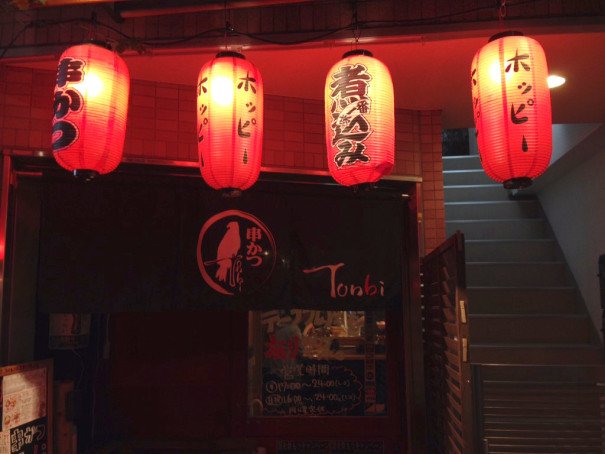
Hoppy and a Shot of Shochu

Hoppy and a Shot of Shochu
Near-beer cocktails in Koenji, Tokyo
We crowd into the izakaya after the jazz set, a grotty establishment on the second floor of an old building within sight of Koenji Station. Inside the bar, a heap of shoes lays higgledy-piggledy at the edge of the raised area where we sit, cross-legged, on tatami mats. If it were a nicer place the shoes would be lined up neatly or even secreted away in tiny shoe lockers with a wooden key, but in this bar such niceties are too frivolous. The guy sitting next to me has a grizzled beard covering jovial cheeks. He orders Hoppy with a shot, and it comes in a cold brown bottle delivered alongside a slug of chilled shochu poured into a frosty glass mug. He pushes it in front of me, the table crowded with bowls heaped with salted edamame and gobo-furai, strips of burdock root mandolined construction-paper thin and fried until crunchy.
Hoppy is a (mostly) non-alcoholic (0.8%) malt and hops-based brew that came onto the scene after WWII, when taxes on beer made the beverage a luxury out of reach for the average working person. It’s a drink born of ingenuity: Hoppy is usually taken poured over a shot of shochu, a domestic distilled spirit that was long known as a working class drink, but is actually more popular in Japan than Nihonshu (known abroad as sake), despite the international fame of the latter. Measured five parts Hoppy to one part shochu, the mix tastes remarkably close to beer, with a similar alcohol content.
In the smeared windows there are flyers with peeling tape at the curling corners advertising happy hour specials. Through them, I can see a few traffic cops shooting the shit at the crosswalk below, shouting reprimands at the sneering blue-haired girl who crosses against the light in front of them. On the corner, a leather-skinned fellow wearing a hachimaki headscarf wrapped around his forehead grills sardines on a brazier, sending smoke up into the neon yellow light warding off the night, while patrons hang off stools awaiting the finished product.
Sipping the Hoppy on its own, the taste is unassuming and bite-less, like drinking beer foam. But once the shochu is added, it has that needed kick, transforming a twinset to jeans and a t-shirt. The best shochu to use is probably imo-jochu, shochu distilled from sweet potatoes, as it has a strong, distinctive flavor that can be rough if taken straight. Mixed with Hoppy, though, it goes down easy, adding just enough attitude to make it interesting.
“Another round!” says the guy. “But don’t worry,” he says to me in an aside. “This won’t give you a hangover.” I’m skeptical, but figure I can always slam a turmeric power drink later as a wager against the morning doldrums.
The decades have passed since the original yen-stretching workaround, and prices have almost gained parity, though Hoppy and shochu is still, measure for measure, a bit cheaper than beer. The drink now has a strong whiff of Showa-era nostalgia, and Hoppy is mostly found in Tokyo, most notably in places that have been around since the postwar period, like the shitamachi (“low town”) area. Look in derelict alleys for watering holes with tattered old chochin paper lanterns glowing red.
“Kampai!” he says. “Kampai!”